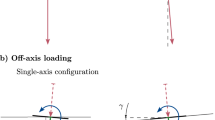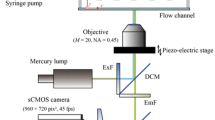Abstract
We present in this paper test results of flexible micro-pillars and pillar arrays for wall shear stress measurements in flows with fluctuating wall shear stress such as unsteady separated flows or turbulent flows. Previous papers reported on the sensing principle and fabrication process. Static calibrations have shown this sensor to have a maximum nonlinearity of 1% over two orders of wall-shear-stress. For measurements in flows with fluctuating wall shear stress the dynamic response has been experimentally verified in an oscillating pipe flow and compared to a calculated response based on Stokes’ and Oseen’s solution for unsteady flow around a cylinder. The results demonstrate good agreement under the given boundary conditions of cylindrical micro-pillars and the limit of viscous Stokes-flow around the pillar. Depending on the fluid and pillar geometry, different response curves result ranging from a flat low-pass filtered response to a strong resonant behavior. Two different methods are developed to detect the frequency content and the directional wall shear stress information from image processing of large sensor films with arrays of micro-pillars of different geometry. Design rules are given to achieve the optimal conditions with respect to signal-to-noise ratio, sensitivity and bandwidth for measurements in turbulent flows.













Similar content being viewed by others
References
Brücker C, Spatz J, Schröder W (2005) Feasability study of wall shear stress imaging using microstructured surfaces with flexible micropillars. Exp Fluids 39:464–474
Chandrasekaran V, Cain A, Nishida T, Cattafesta LN, Sheplak M (2005) Dynamic calibration for thermal shear-stress sensors with mean flow. Exp Fluids 39:56–65
Fahy F, Walker J (1998) Fundamentals of noise and vibration. E & FN Spon, London
Landau LD, Lifschitz EM (1966) Lehrbuch der theoretischen Physik. Band 6 Hydrodynamik. Akademie, Berlin
Morfey CL, Tan M (2001) Unsteady drag on a Cylinder due to transverse oscillation at finite amplitude. J Sound Vib 264(4):705–721
Padmanabhan A, Sheplak M, Breuer KS, Schmidt MA (1997) Micromachined sensors for static and dynamic shear-stress measurements in aerodynamic flows. In: Proceedings of the IEEE transducers ’97 conference, Chicago
Scott M (2004) The need for a shear stress calibration standard. In: 24th AIAA Aerodynamic Measurement Technology and Ground Testing Conference, Portland, 28 June–1 July, 2004, AIAA-2004-2302
Sexl T (1930) Über den von E.G. Richardson entdeckten “Annulareffekt”. Z Physik 61:349–362
Uchida S (1956) The pulsating viscous flow superposed on the steady laminar motion of incompressible fluid in a circular pipe. ZAMP 7:403–422
Venier P, Maggs AC, Carlier MF, Pantaloni D (1994) Analysis of microtubule rigidity using hydrodynamic flow and thermal fluctuations. J Biol Chem 269:13353–13360
Acknowledgments
The authors gratefully acknowledge the support of this project by the Deutsche Forschungsgemeinschaft DFG. In addition, the authors thank Dipl.-Ing. Sebastian Kunze, Armin Keißner and David Hess.
Author information
Authors and Affiliations
Corresponding author
Appendix
Appendix
The governing differential equation for the pillar motion using quasi steady drag force approximation by Oseen for small Reynolds numbers including added mass reads
As mentioned before this equation is still length dependent. In order to transfer Eq. 16 into a form of a simplified mechanical system given by Eq. 7 it has to be integrated over z. For low frequencies (ω ≪ ω n,0, one order lower than the natural frequency in vacuum) and small pillar displacement amplitudes (w max ≈ D) one can drop the time dependent terms of damping and inertia to obtain the spatial shape of the deflection for a given load profile. This leads to the differential equation for the static deflection line of a uniform, homogeneous, circular cantilever beam clamped on one side.
Since the pillars stand within the very near wall region the force per unit length acting on the pillar is changing approximately linearly with the pillar’s lengthwise coordinate z. This equation can now be solved with the following boundary conditions, d3 w/dz 3| L = 0 (no internal shear force at z = L), d2 w/dz 2| L = 0 (no bending moment at z = L), dw/dz|0 = 0 (no rotation of the beam at z = 0), w(0) = 0 (no deflection of the beam at z = 0). This leads to the following equation of the static deflection of the pillar as a function of z.
The tip displacement is linear proportional to total force F 0. Therefore, the proportional constant can be interpreted as the inverse of the spring stiffness or compliance (1/k*) and the term in the brackets Φs(z) represents the spatial shape. With the assumptions made above the spring stiffness can be considered to be constant in the static and oscillatory system.
For small bending amplitudes and quasi steady conditions it is acceptable to separate the pillar motion into a spatial mode (Φs(z)) and a temporal modulation.
If the spatial shape of the deflection is known Eq. 16 can be integrated over the pillar length yielding to a constant damping coefficient and accelerated mass (mass plus added mass) of the simplified mechanical system.
The assumption of a linear velocity profile in the near wall region leads to the following equivalent excitation force of the mechanical system at the pillar tip.
By inserting finally m*, k*, c* and F(t) into Eq. 7 the simplified mechanical model for the calculation of the frequency response is complete and reads:
Rights and permissions
About this article
Cite this article
Brücker, C., Bauer, D. & Chaves, H. Dynamic response of micro-pillar sensors measuring fluctuating wall-shear-stress. Exp Fluids 42, 737–749 (2007). https://doi.org/10.1007/s00348-007-0282-6
Received:
Revised:
Accepted:
Published:
Issue Date:
DOI: https://doi.org/10.1007/s00348-007-0282-6




